 London
London
Greetings and welcome to the ye olde first length of this quest throughout Brittania. I shall be your guide and host Lord Benjamina of Essex and will take you on an adventure throughout history and the present on the area known as Brittania...if thou wishes to see these photo's in chronological order then all thou must do is click on the 'March!' button down the bottom or to go back click on the button marked as 'Retreat!' and please sign the guestbook. The area to which the page is responding to is coloured in red on the map...

After leaving Brisbane, Australia - it was time to embark on British Airways and adventure to Londinium. This 'sojourn' was to take just under 24 hours, with a 4 hour stoppover in Singapore. I decided against having the free flagons of ale that were offered deciding that I would already get lost in Heathrow and wouldn't need the effects of alcohol to aid this. Heathrow was suprisingly easy to navigate, and all the people there were really friendly - except one Indian guy who I don't think liked me.
After answering a barrage of questions to the Customs officials, it was time to find my way to the inn where I would be spending the night, The Royal National Hotel. There were two ways to do this, the Underground or an Airbus. I opted for the airbus, as (a) I would get to see lots of London on the top of a double decker bus and (b) they drop you right outside your hotel. This turned out to be more expensive, but worthwhile. I arrived at the hotel at around 9 in the morning, and it was still dark! And it turned out I couldn't check in till 2pm so I decided to call everyone and then have a wander and this is where my quest begins.....
Just a note: I have never really owned a camera before and didn't realise that when you take a picture in a bus, with a flash and while it's raining it would turn out bad. So it is that I have replaced many of my dodgy pictures with that of those supplied by Richard Davis, richardd@fan.net.au - a fellow adventurer on the Contiki tour. His photo's are any with the date stamp on the picture...
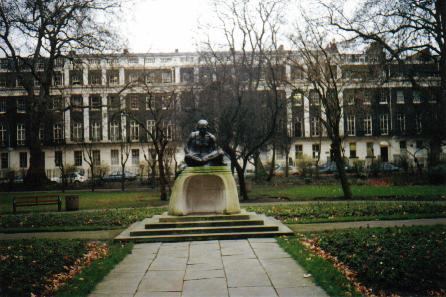
The Ghandi Memorial, Russel Square London, 12.01.00
After briefly resting my socks, I went off on a walking exploration of London. The first place of interest was The Ghandi Memorial located in Russel Square (next to the hotel). Mohandas "Mahatma" Ghandi was, I believe, one of the greatest individuals to have ever walked this earth, his work towards peace and freedom will be remembered forever.

The British Museum, London, 12.01.00
Unfortunately, when I arrived at the British Museum there was a lot of construction work going on, however most of it was still open. The musuem houses many artifacts you only see and read about in the books, such as the actual mummified body of Queen Cleopatra of Egypt, pages from Egyptian Book of the Dead, the "Peat Man" as well as a virually horde of other lesser known artifacts. The musuem, when I arrived, was free - though donating is highly recommended as they do try and save our past.
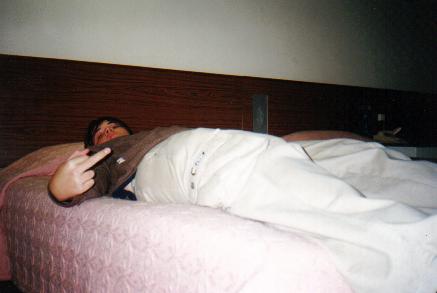
Royal National Hotel, London, 12.01.00
Being very disgruntled in this state of being known as "jetlag" I decided to rather rudely give a gesture before passing into unconsciousness...
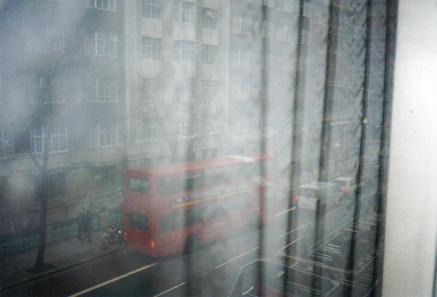
Double Decker Bus, London, 12.01.00
As it was, I slept very little so got up and took this photo of one of London's trademarks - the'double decker bus'. After sitting around for about an hour trying to work out how to use the hotel's kettle, I then decided to do absolutely nothing for a couple more hours. By night, it was time to check in for the Contiki tour which I was booked on, here we got a rundown of everything and met each other as well as did all paperwork stuff. I was so wasted by this stage so retired to my quarters. Here I met my room mates for the night who bagged me for not stocking up on duty free, and then fell into a deep slumber...

Big Ben, Westminster 13.01.00
It seemed as though I had just got to sleep by the time I woke up, but despite this I had to make a hasty departure and head to the Contiki bus ready for the London city tour. The chariot had been fully equipped and now it was time for our party of adventurers to explore the cities of London and Westminster. This is Big Ben, located on the River Thames and a part of the parliament buildings structure. It is the most photographed clock in the world, and also the official timekeeper of England.

Buckingham Palace, London 13.01.00
Buckingham Palace has been the home of the sovereign since Queen Victoria - though the Queen does not reside here all the time. Originally built in 1703 for the Duke of Buckingham, it was later remodeled for George IV but was not fully finalised until 1903. This is perhaps one of England's most visited attraction - especially for the changing of the guards.
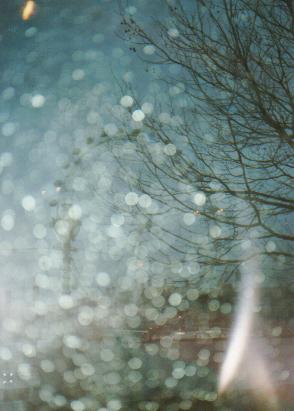
Eye of London (Millenium Wheel), London 13.01.00
A giant ferris-wheel located on the Thames - this was supposed to be up and running for the new year but this great pride fell amiss as it broke down - it is supposed to offer the best view of London to which it would want to at the price of £20.00.

A Section of the Houses of Parliament

Statue to the front of Buckingham Palace
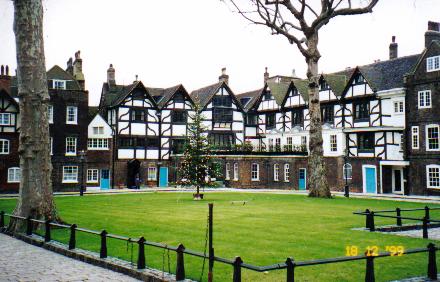
Tower of London, Inner Courtyard
The Tower of London is one of those 'must-see' things in London, especially for its vast armoury. Unfortunately I didn't go inside though did see the outer reaches of it. This tower was especially active in the Peasant's Revolt mentioned below. The next photos are several shots of the tower.
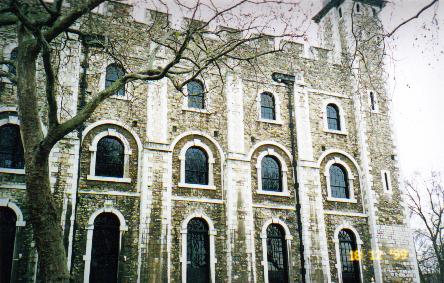
Tower of London - White Tower (Armoury)
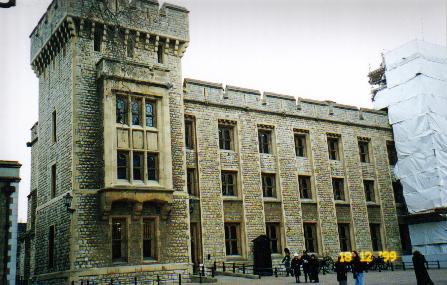
Tower of London - Jewel House (Home of the Crown Jewels)
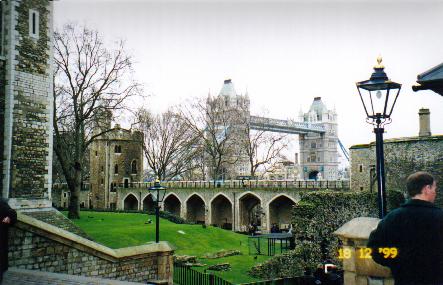
Tower Bridge from the Tower of London
The year 55 B.C. was to bring the first Roman invasion of the British Isles under Julius Caeser (then general of the Roman Armies in Gaul). This invasion failed and the next attack came under Emperor Cladius in the First Century. The armies of Rome invaded at nowadays Kent, and set up capitol at Colchester. Having a good sense for the strategic values of the River Thames, a small settlement was set up as a trade and administrative center called 'Londinium' (London). Londinium thrived with trade, was an effective communications center and the center for troop movement. It quickly became the most important town in Brittania and thus became capital.
The Roman Legions withdrew in the fifth century, leaving a new culture in its wake - the 'Romano-Celts', who had to fend for themselves. They too were overrun by a Germanic tribe called the Saxons who quickly took over. It was in this period that such legendary figures as King Arthur were thought to have existed, he was thought to be a Romano-Celt who held back the Saxons namely in the Battle of Badon Hill. The Saxons in turn were overrun by a tribe called the Normans ('North-Men'- who were Vikings who settled in the north of France), at the Battle of Hastings (1066 A.D.). The Normans under William 'The Conquerer' introduced feudalism into England, which was a political and social system where certain rights and duties existed between the lord and his subjects.
This system collapsed after the Black Death (1350 A.D.) though showed signs of ruin before this, and Capitalism started to emerge. Civil strife took hold of London in 1381 A.D. with what is known as the 'Peasant's Revolt' where oppressed peasants (and other classes) marched on London and demanded reform, most of which were tricked into leaving and later slaughtered under the young King Richard II.
In the later half of the Medieval period, two of the most famous education institutions were set up in England - both of which still exist and are used. The first is the great Oxford University who was amongst only a few universities of the time which really excelled. The second was Cambridge University which actually was formed as a result of a walkout from Oxford.
War seems to have always been apart of the British history, both civil and external. It had endured several invasions so really comes to us as a historical multi-tribal people. From the Norman invasion onwards, civil strife seemed to be on the increase. Problems from Wales, Ireland and Scotland emerged, some of which will be talked about in the appropriate sections. The major occurance of civil strife happened in the seventeenth century known as the 'English Civil War', this was to divide England between those who sided with the Royalists (Cavaliers) under King Charles I and those who sided with the Parliament (Roundheads) under Oliver Cromwell. This effectively led to years of warring and confusion. More problems came in the eighteenth century when the recently 'ousted' Stuart Dynasty was supported by the jacobites, who were in some aspects outlawed. This in particularly took form in the Highland regions of Scotland, discussed later. The problems with Scotland and Wales were 'quelled' more or less, yet the problems with Ireland remain to this day, where both Protestants and Catholics took to guerilla/terrorist activities in the northern reaches of Ireland.
Britain took a solid form in both of the major wars in the earlier half of the twentieth century fighting in Europe on several fronts, after which its world hegemony declined to that of the United States of America.
On to the city of Windsor, Windsor Caslte and Eton College...
Please sign ze Guestbook mon ami's...
The Benjamina Fund of The Judean People's Front